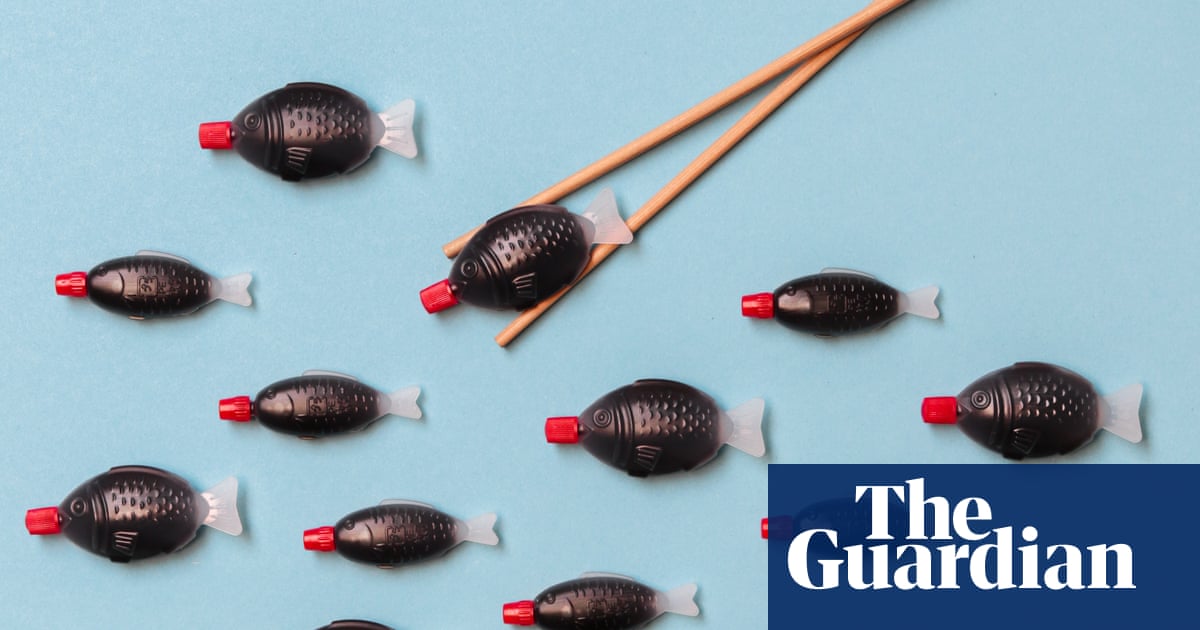- cross-posted to:
- [email protected]
- cross-posted to:
- [email protected]
The device known as shoyu-tai (or soy-sauce snapper in Japanese) was invented in 1954 by Teruo Watanabe, the founder of Osaka-based company Asahi Sogyo, according to a report from Japan’s Radio Kansai.
It was then common for glass and ceramic containers to be used but the advent of cheap industrial plastics allowed the creation of a small polyethylene container in the shape of a fish, officially named the “Lunch Charm”.
The invention quickly spread around Japan and eventually worldwide, and it is estimated that billions have been produced.
Date rapists in shambles
For context, these containers are really popular for storing drugs like GHB
I’m not defending the use but should mention that these are convenient over traditional sauce packets. They allow precise application in a droplet form, don’t spill everywhere, and can be closed with the included cap.
But offer no benefit over a simple serving bottle.
Portability and cost.
I don’t support single use plastics but saying no benefit is just willfully ignorant and causes alternatives to fail for missing the point.
It could just be waxed paper/waxed cardboard like the milk cartons of yore, but small. A lot of this stuff has been around long before plastics, and we got by just fine :)
Portability is a fair point, but I feel like we shouldn’t count cost, since that’s the line of thinking that got us into this mess.
Unfortunate reality while we still have capitalism. Plastic bags are banned where I am but they still show up regularly
saying no benefit is just willfully ignorant and causes alternatives to fail
It also plays into the conservative point of view that everybody who gives a shit about the biosphere is just as ignorant as they are, and that the reasons for taking away their plastic straws and grocery bags have to do with evil communist america-destruction rather than preventing things like micro plastics in the organs of developing fetuses and global climate change.
Ignorance and pretending a problem doesn’t exist is like step 0 of most conservative policies.
Correct. These are often found in takeaway containers.
The “fish-shaped” is rather irrelevant. The point is that it is a single -use plastic thing. With very little content in relation to the plastic used.
I thought it would have been very relevant.
It looks like a fish lure.
If this is floating around at sea I don’t see why other fish (and maybe certain sea birds?) wouldn’t think it’s prey, and it even has a bright red indicator that makes it easy to spot.
Only relevant for countries that still “recycle” plastics by throwing them into the sea.
So all of them.
Some thrash will end up in nature no matter what you do, especially small and light items. That’s why it’s good practice to design packaging do that it does minimal harm if it ends up in nature.
I’ve never seen these things before but it does seem like a waste of plastic. Even sachets of sauce shouldn’t be handed out in most circumstances, at least for dine-in food in fast food places - use dispensers and paper cups. I wonder if there is a biodegradable sachet material which has a couple of years shelf life but degrades thereafter.
I was thinking about these literally just yesterday. I’m wondering if they could be essentially replaced with something like those wax bottle candies. Maybe not the best for places that reach extreme temperatures but some places could do it without issue.
Wonder if you could put soy sauce in wax like those wax bottle candies instead
If it exists, I can’t wait to hand these out during Halloween
Some people just don’t appreciate the irony of killing turtles with fish-shaped plastic, what can you do
You know what’s killing more turtles? Irresponsible mega-corporations.
Nothing is ever produced by them that isn’t bought by someone who should have said no.
If companies are to blame then that’s the media companies who don’t inform the consumers about their responsibilities but instead sell ads for harmful products.
Good luck relying on informed customers when customers are too busy living their lives to keep track of a billion different reasons for why they shouldn’t buy one product over another. Also, these are given out at restaurants. Do you recommend refusing to go to a restaurant if they happen to see this dispenser being included there?
How is making sure millions of people are informed and making the “correct” decision every time a better solution than simply restricting on the supply side?
It’s the only way to make a change. Businesses can buy politicians to avoid regulations.
It’d cost more to buy out the politicians than to switch to the sachets that are still allowed. The sachets are cheaper to produce since they use less plastic and businesses would be happy to be “forced” to switch to a cheaper alternative along with all their competitors.
No, you can’t blame consumers for corporations bad behavior, consumers act in their own self interest, not a collective self interest. This is precisely why we have regulations.
I blame the humans who keep being consumers.
Those are cute and I can see how they would be popular. And I see why they should also be banned. I live in the Midwest and I’m not sure I have seen these. Ours just comes in a little sauce packet.
Essentially a less cute plastic wrapper, no?
Yeah but as another person from the American Midwest, the article seems to indicate south Australia is moving to the packets we have as they’re larger and use less plastic, though the goal is for bulk soy sauce in refillable containers
In Australia we have these or the packets, for take away. You don’t use them for dine in, we have larger refillable glass/plastic containers for that.
Kind of but it’s still a fraction of the waste created. Not perfect but I’d say the polyethylene ones take up 5 to 10 times more space in a landfill or ocean.
yeah, i’m thinking about our taco bell sauce packets. would they put them in little soy sauce bottles at every table? little cholula bottles with the cute wooden stoppers? what would they do if they couldn’t
bribelobby their way out of this?
A Spanish company (I imagine there are a few worldwide) develops compostable bioplastic containers using PLA, polylactic acid, the most used plastic in 3D printing, in food safe formulations. I suppose there are limitations on what it can contain, and I don’t know if soy sauce is compatible. I know that it’s used for single serving olive oil, for example. There are challenges, like storage life, but it’s a good start.
I do a lot of 3D printing. Printing PLA things for food storage is not recommended, not because of PLA, but because filaments often have modifiers to enhance certain properties that may not be food safe, and because contact with materials and parts, like extrusion nozzles may add impurities that are probably not food safe…
Keep in mind that PLA also leaks microplastics into food and could also be considered a risk to health just like other plastics.
Aren’t these biodegradable, though? I imagine the body would eventually process them, unlike hydrocarbon based plastics.
“Biodegradable” doesn’t mean “biodegradable in the conditions in the human body.” Lots of ‘green’ plastics are only compostable at a fairly high temperature (120F/50C) and with specific bacteria present.
PLA is not one of those. It’s used in biodegradable implants. Even fairly large bone screws will dissolve within a couple years.
Biodegradable ( “green” ) needs a new definition
I’ve started to see home compostable on some packages.
Some people just don’t appreciate the irony of killing turtles with fish-shaped plastic, what can you do
PLA isn’t food safe in 3d printing mostly because of layers on a print trap foreign material / bacteria and water can also seep into microscopic gaps into infill and it becomes a breeding ground. I doubt it would be useful for anything squeezy but it might be useful for single use forks and other utensils. But paper / wood can do those things already so I don’t see PLA being much use. For sachets I expect the answer is paper with some kind of biodegradable lining which gives a product a shelf life of a few years but does degrade in time.
Also, some “biodegradable” products are only compostable in specialist facilities where it can be shredded and broken down with water / heat / pressure. I think PLA is a bit like that. If you print something out of PLA and stick it out in the garden or even toss it into a compost bin it’ll still be there in 10 years although it might be faded, warped & brittle. Maybe it eventually biodegrades but it’s not quick enough.
The hard part about PLA is that while it is biodegradable, it’s only in certain conditions/facilities who are set up for it, and it’s not very common around the country. I’m all for what the company is doing, and I already do see a lot of PLA products in fast food (like soda cups), but it doesn’t mean much if we don’t have the facilities to properly dispose of it.
Source: I do a modest amount of 3D printing
I’m definitely not a polymer expert, I also have my information from what I read as a hobbyist. My take is that while PLA will compost in commercial facilities, it will eventually biodegrade in a reasonable time frame, with minor impact to nature. Better than the alternatives, I guess.
How does it biodegrade though?
Just like disintegrate into tiny plastic molecules that we can no longer see but it’s still plastic? Or does it degrade as far as becoming the individual components that made up the plastic and can be recycled and used by things in nature?
I don’t know. As I mentioned elsewhere I’m not a chemical engineer, but I imagine that being made from starches, it may be decomposed into digestible compounds. Just guessing here.
Pla is poly lactic acid, so it breaks down into lactic acid and then further into water and CO2 with heat and bacteria exposure.
PLA is pretty brittle AFAIK. these need to be squeezed, so i’m not sure it’d do… perhaps they could add something to it? but whether that additive would also be compostable… it’d certainly make it non-recyclable
I used to buy the olive oil containers for a restaurant I owned. They worked quite well. Small single serving cups with a peel off lid. I don’t know if the lids were bioplastic, though.
Unfortunately while PLA is technically biodegradable, it requires very specific conditions that can only be achieved in dedicated facilities. So it’s not like you can throw it in the composting bin and be done with it. It will also survive for a long time in nature.
Sure, but PLA will eventually biodegrade, unlike things like polypropilene or polyethylene, which are incredibly useful precisely because of their imperviousness.
is this like for food delivery?
Scrolling by I literally thought “Man, that candy looks delicious, what’s this article about?” And then read the headline… 🫠
Oh no! How are people supposed to sneak G into parties now?
Contact lens case is how they did it around here.
Based
I have never once seen one of these. Interesting.
I have an idea, just stop putting them in the ocean.
I love productive comments.
oh fuck, i wasnt supposed to save all my plastic containers until my next day at the beach???
some jerk: i havE aN idEa, NO
I’ve got a fridge drawer for these.
I never knew these existed and now I kindof want one. Lol maybe I’ll see one in an antique store in 40 years














